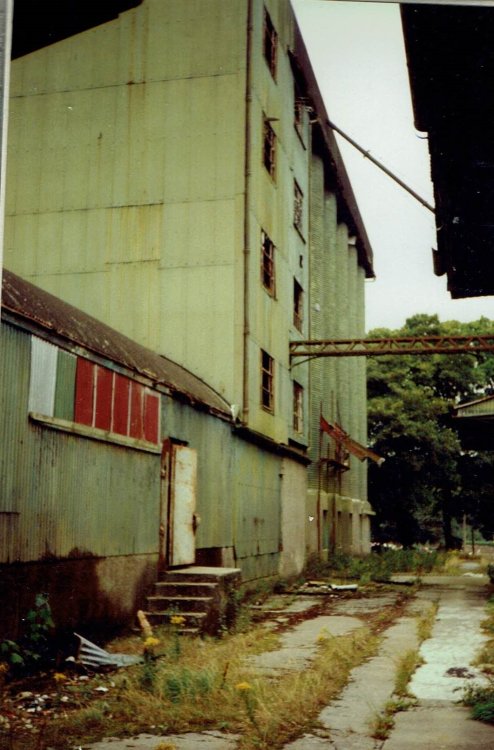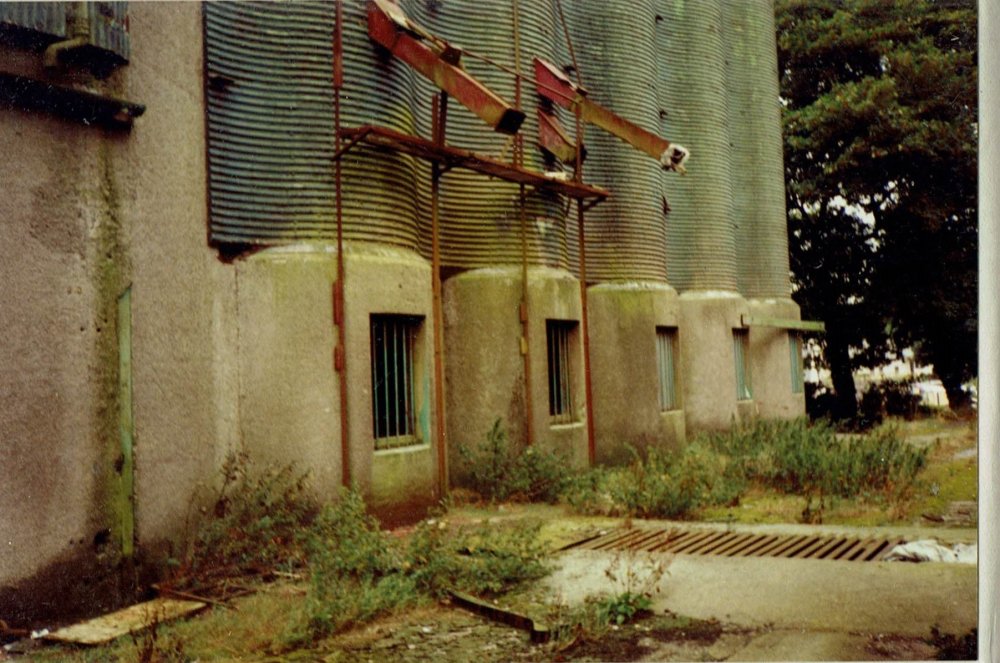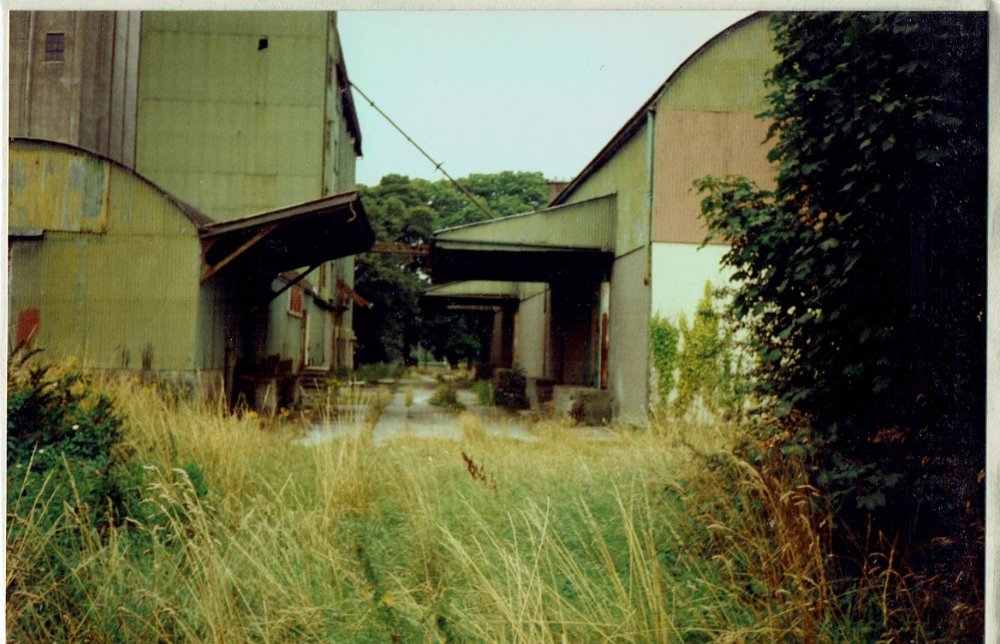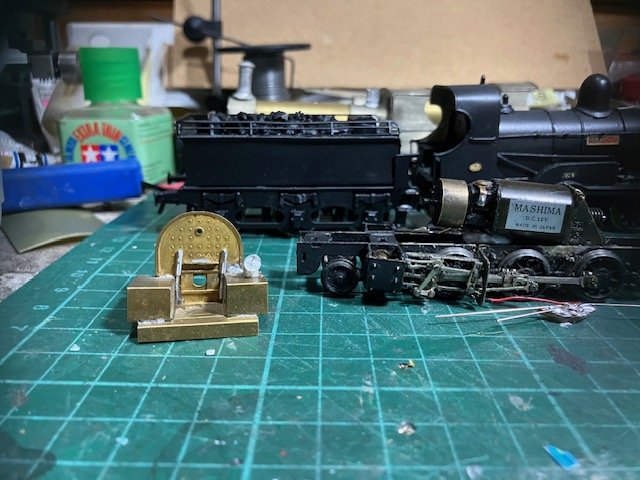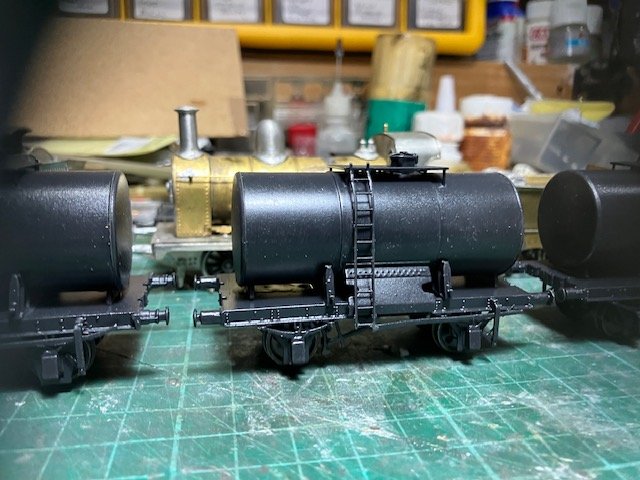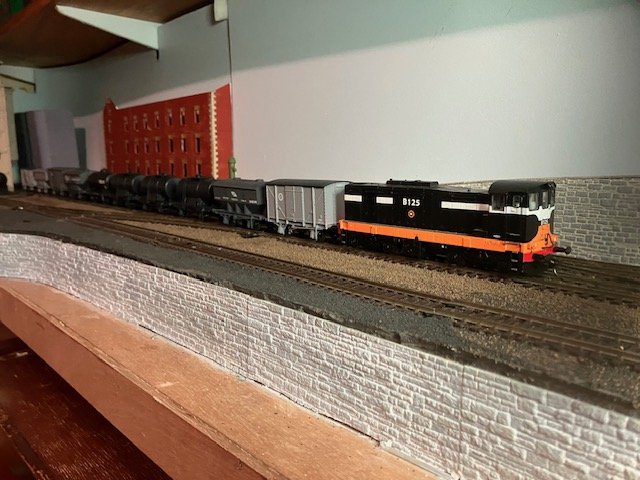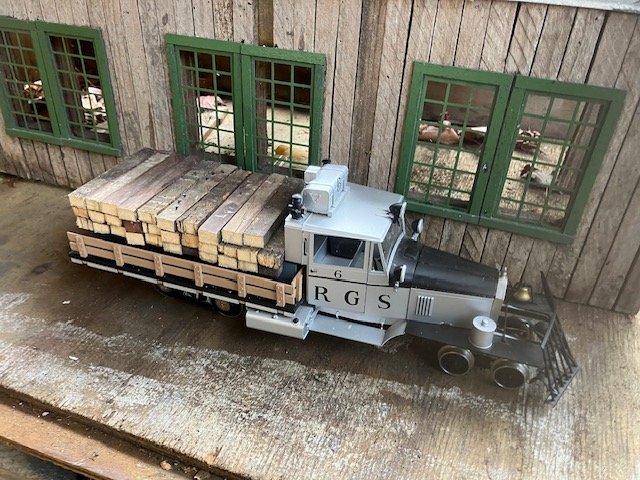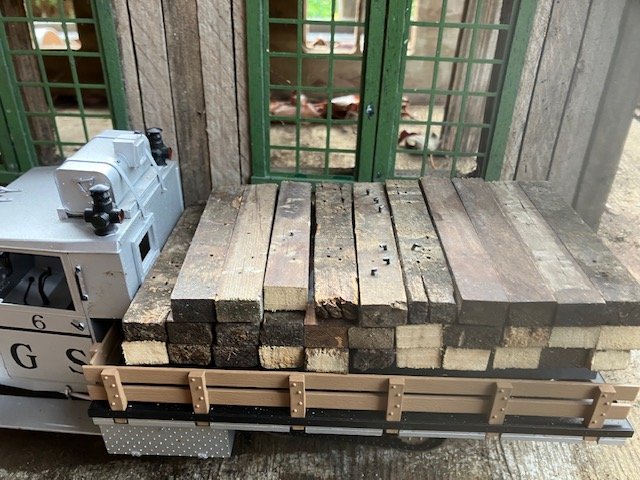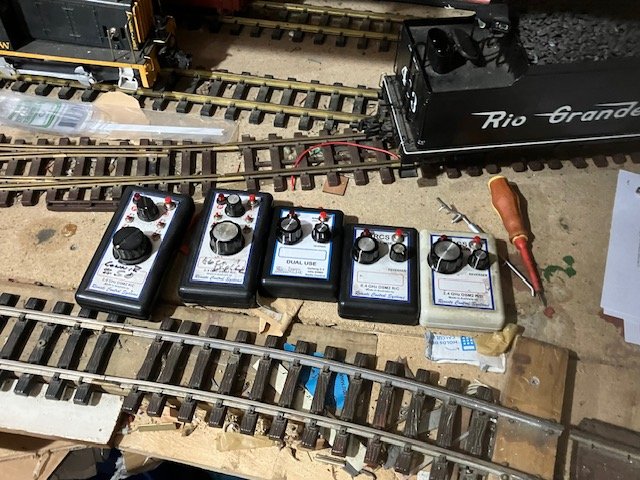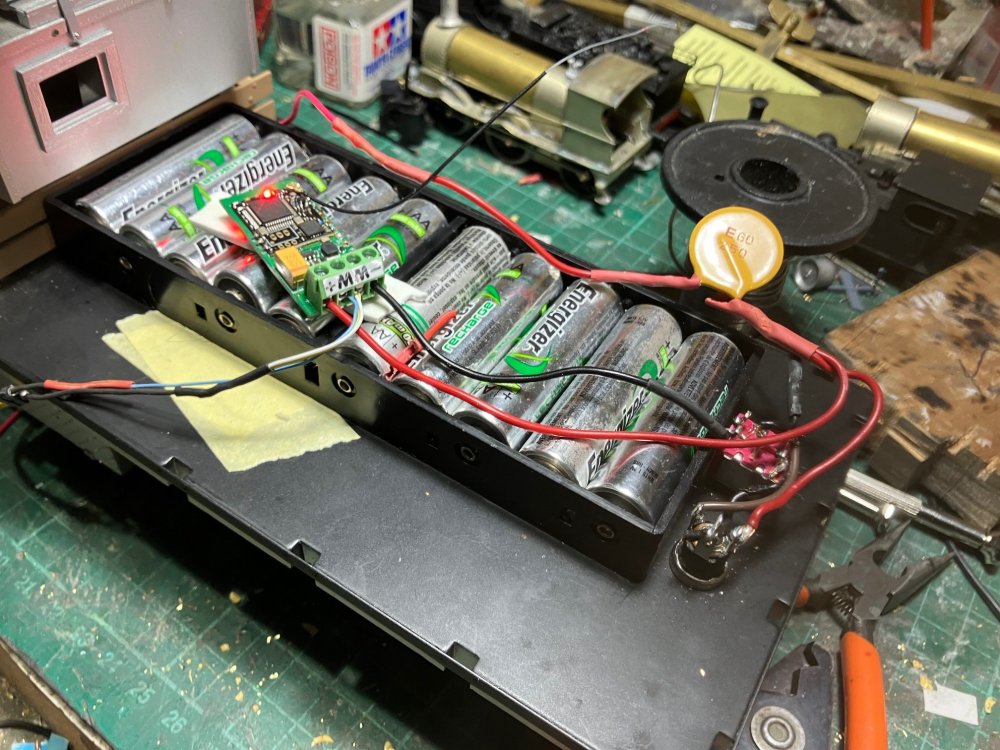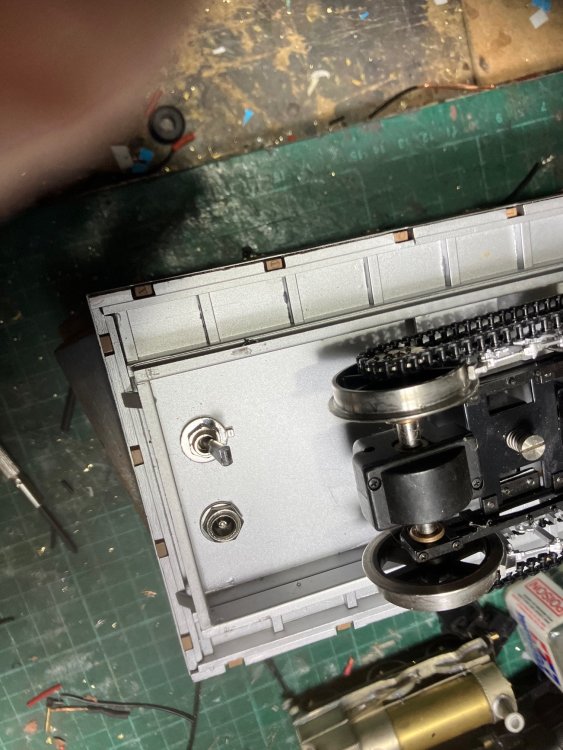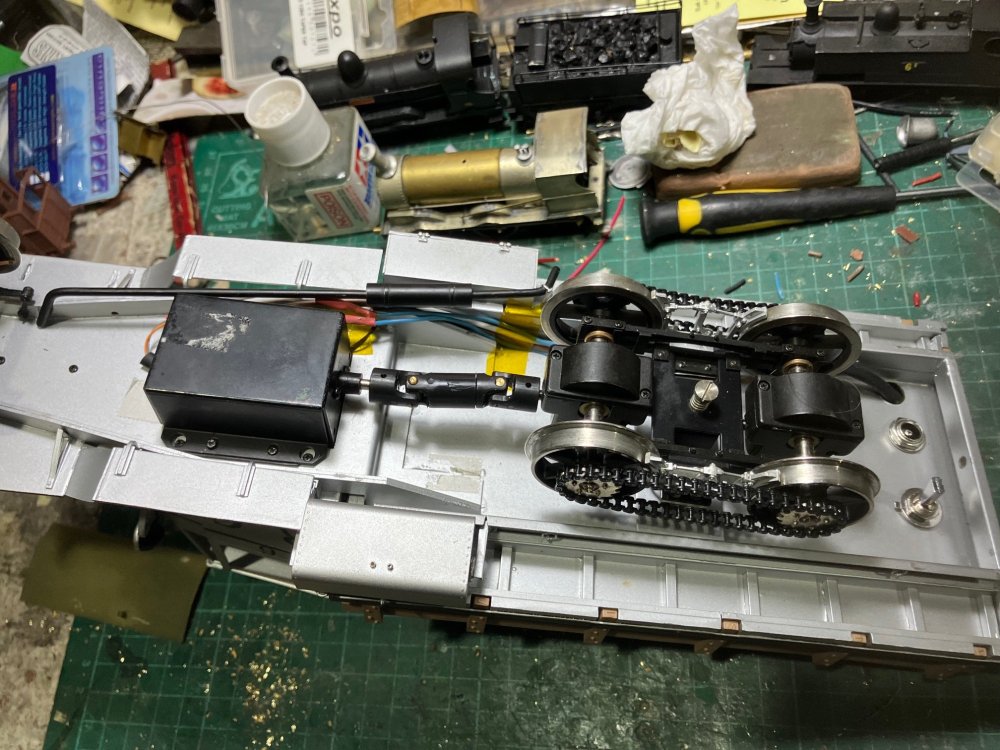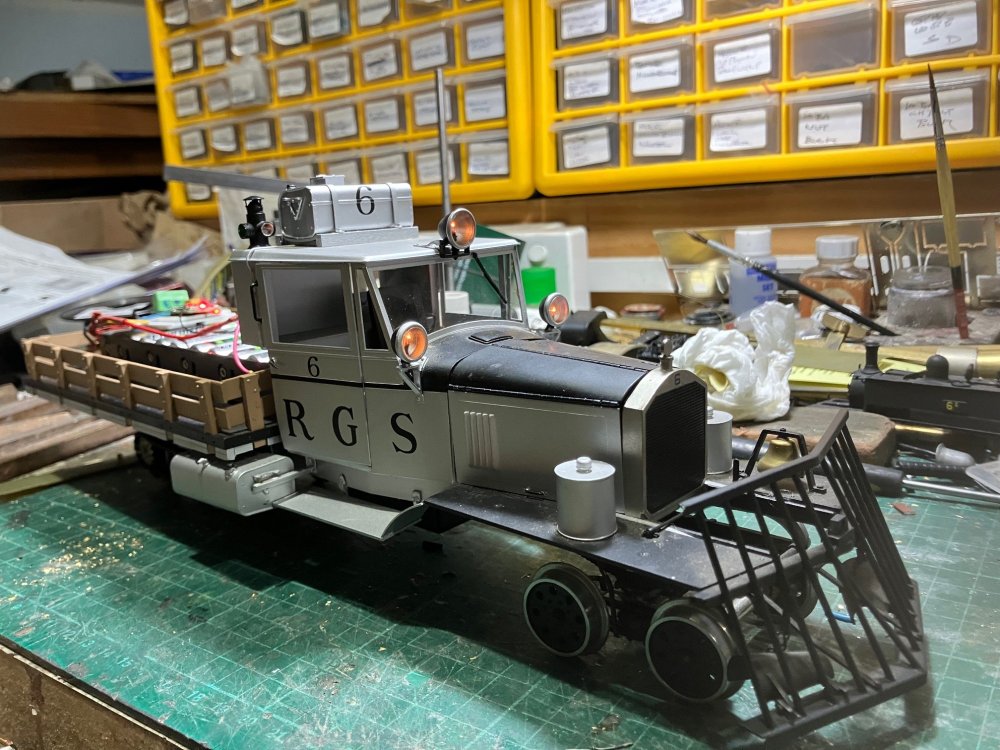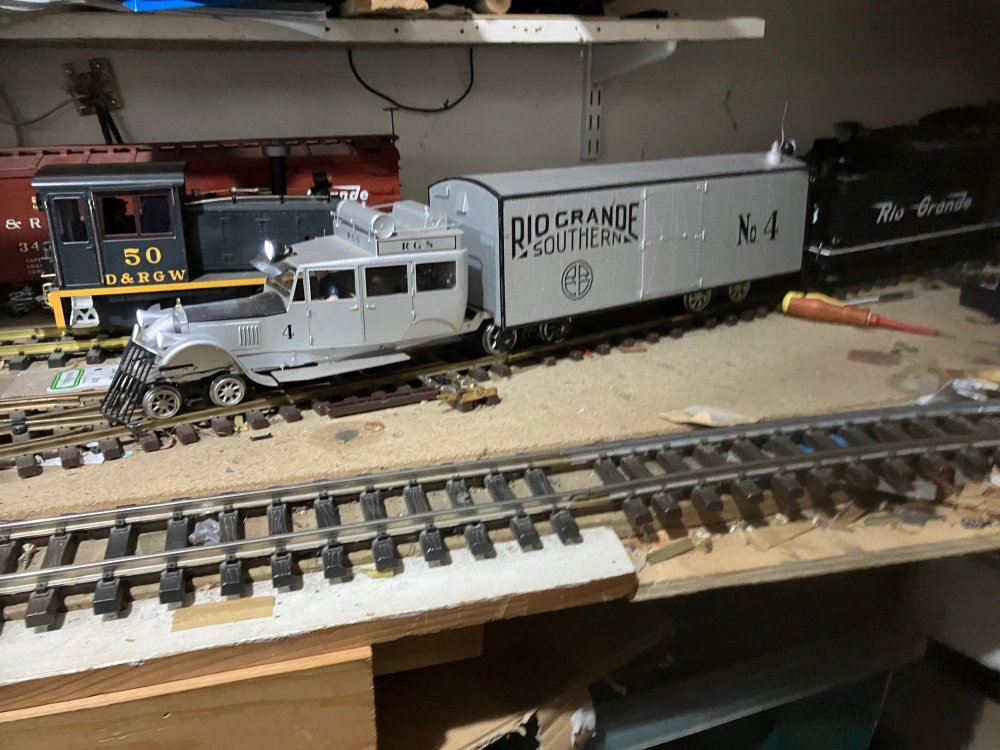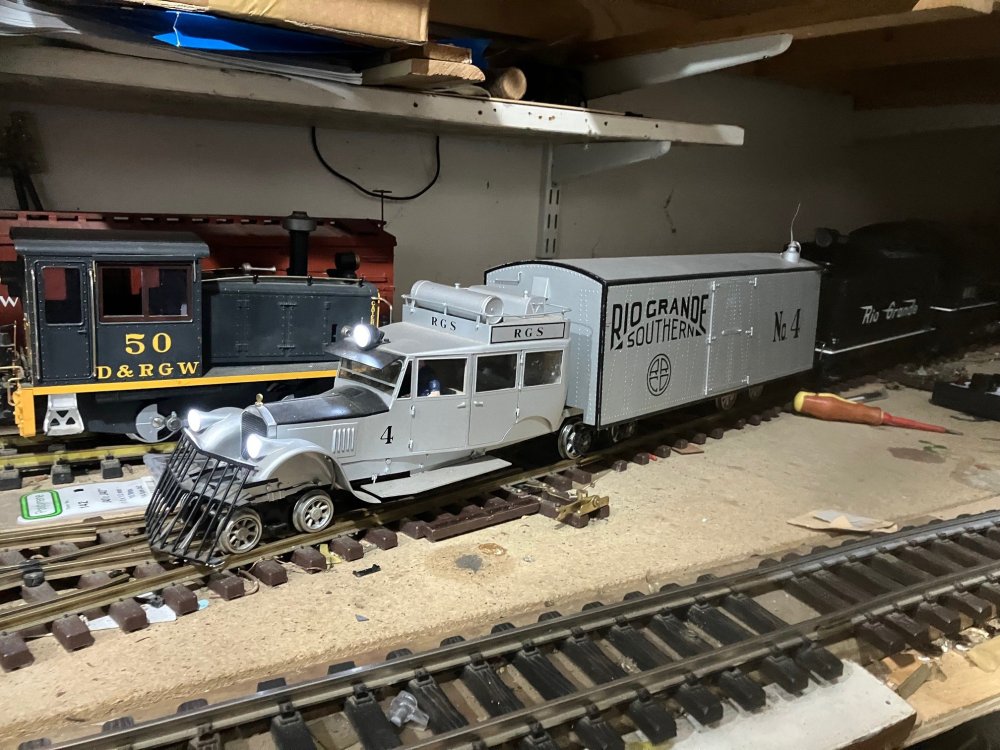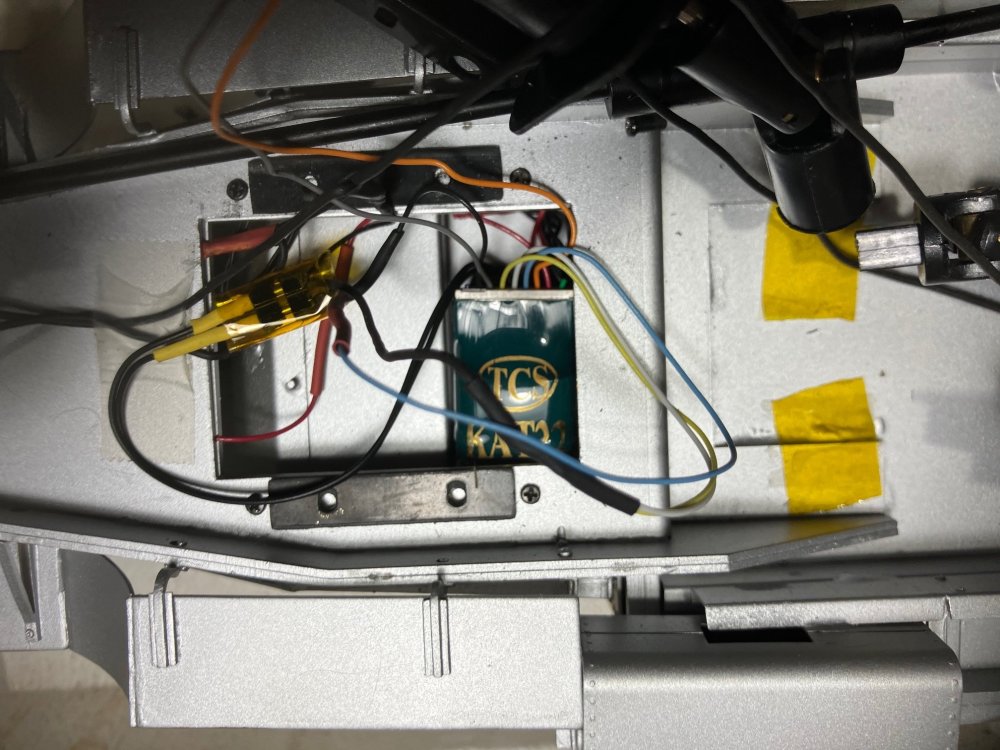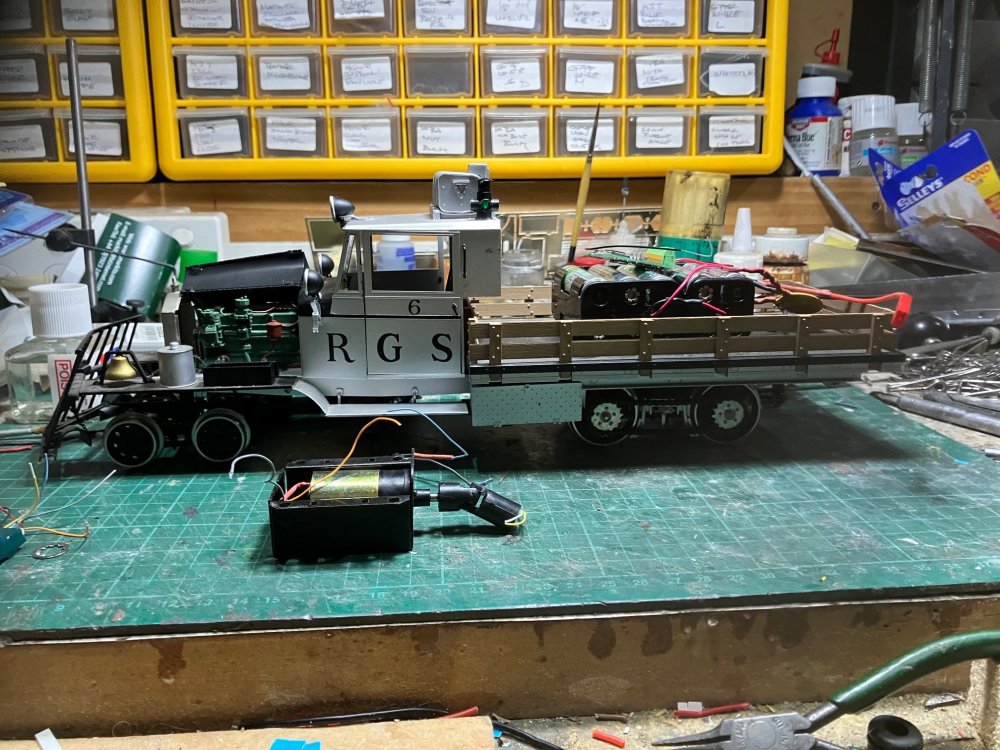-
Posts
4,872 -
Joined
-
Last visited
-
Days Won
119
Content Type
Profiles
Forums
Events
Gallery
Blogs
Store
Community Map
Everything posted by Mayner
-
I remember reading somewhere and possibly seeing a photo of a 'Tender Train" that used to run to Limerick Junction before the installation of a water softening plant possibly in the 30s, there was a similar plant at Ballybrophy. There was a comment that the train was made up of tenders from withdrawn locos Look like CIE days late 1940s a train of tenders from oil burning locos with white circle and ladders, first two appear to be Woolwich tenders. Possibly a move between Limerick/Cork and Inchacore works. I remember reading somewhere and seeing a photo of a Limerick Junction 'water train' made up of tenders from withdrawn locos that operated before the installation of water softening plant by the GSR, the GSR also installed a similar plant at Ballybrophy.
-
It looks like there is a Velorail operation North and South of Kiltimagh on the Burma Road, no mention of the operation on this Newsgroup, worth while checking out? https://www.velorail.ie/#home
-
"Rail Cruising' operations using self drive "Buggies" have become successful tourist operations on disused railway lines over the past 10-15 years. The Rotorua operation uses purpose built cars, the "Forgotten World' operation uses converted golf buggies. Both are commercial operations on 'mothballed' lines without Council or Government funding.
-
Not the most exciting of processes, I once turned down an invitation from a Budweiser buyer in the States to spend a day watching a grain train (80-100 car) being loaded instead spending the day chasing trains on the main lines. Haven't come across any photos of grain wagons being loaded, though there was a photo in the O'Dea Collection of grain being transferred from an ex-GSR wagon to a grain lorry at Fermoy using a portable conveyor during the 1960s. Grain traffic would have been handled as wagon loads with individual or small cuts of wagons marshalled in a loose coupled train rather than the Block Trains of grain containers that were operated for Greencore during the 1990s. Grain wagons were scarce on a railway where Covered and Open wagons predominated, during the 1930s the GSR built 10 for its own use and 8 for Ranks Ireland Traffic, CIE added an additional 105 by 1961. Its likely that the grain elevators at Dublin, Cork and Waterford ports were the main originating (loading) points for grain traffic, though Ferns and possibly other stations in County Wexford were originating points for grain during the CIE era. Its possible that locally grown barley for brewing was loaded in counties with a warmer drier climate, CIE believed that malt traffic was important enough to build a small number (6?) of ISO hopper containers for bulk grain traffic during the late 70s While the elevators at the ports tended to be classical early-mid 20th Century concrete structures https://councilmeetings.dublincity.ie/documents/s30902/155 Addition to RPS RH Hall Silo Alexandra Road D1.pdf, corrugated iron was widely used as a cladding material on elevators and grain storage buildings at mills and loading points. Photos from Clara are fairly typical of the use of corrugated iron on Irish industrial sites, the chutes typical of the loading arrangements for grain wagons at an elevator. CIE used a G Class as Clara pilot loco which is likely to have shunted Ranks Mill. Loading Shovels are often used for positioning/switching grain cars at elevators in the United States and Poloxfens apparently used a tractor to shunt wagons at their Ballysodare Mill.
-
The Lucan tramway went through several distinct stages, opening as a 3' gauge steam tramway from Conyngham Rd to Lucan and later extended to Leixlip. The tramway was later converted to electric traction on a gauge of 3'6" and the section from the Spa Hotel to Leixlip abandoned (early 1900?) The Lucan tramway was taken over by the DUTC during the 1920s and integrated into the Dublin tramway system with trams running through from the City Centre to Lucan. The Conyhgham Road Bus Depot is on the site of the Dublin & Lucan tram depot and works. The land on the Palmerstown side of the Farmleigh Bridge was once a sand or gravel pit and used as a landfill for many years. Rail was often sold locally to farmers and local businesses after lines closed. I demolished a building in Killiney in the early 80s in which tramway rails were used a support beams for a concrete roof, I intended but did not use one of the tram rails as a beam in a house renovation in Phibsborough and may have left the rail in the garden.
-
#6 is considered to be a Rio Grande Southern Galloping Goose although never used for mail or passenger/tourist traffic. Although RGS management put in a bid to take over and operate the Colorado and Southern "South Park" line and operate it with 'motors" similar to the RGS the bid was not accepted and the South Park remained steam work until abandoned/converted to Standard Gauge.
-
Looks like a 21st Century development of the Brennan Monorail https://en.wikipedia.org/wiki/Gyro_monorail
-
The ballast underlay (mat?) looks really effective for a layout of this nature which features a lot of track and action in a small space. It reminds me of the vintage Hornby & Triang layouts that sometimes appear at some clubs and exhibitions and are great fun to see in action. https://www.youtube.com/watch?v=yQBu8vWVHZQ, possibly best to focus on the track trains and railway buildings and leave the scenic side to a minimum. Reach-in to the opposite side of the layout (to clean track, re-rail stock, change points) could be challenging as the long side of the layout appears very close to the wall for a workable isle. Two foot is generally considered to be a workable limit in terms of reach in distance. One of the advantages of Set track is that you can test and if necessary alter a layout before pinning down the track or gluing loose ballast. Looks like an excellent layout for watching trains and displaying stock with a double track main line and several sidings
-
A small batch of rtr Brake Vans is currently available on our web site https://jmdesignmodelrailways.com/ as we use up our stock of Brake Van decals and packaging material. I have ceased the production of our 3D printed wagons as it not worthwhile continuing as a result of high production costs relative to the level of demand.
-
A small batch of rtr Brake Vans is currently available on our web site https://jmdesignmodelrailways.com/ as we use up our stock of Brake Van decals and packaging material. I have ceased the production of our 3D printed wagons as it not worthwhile continuing as a result of high production costs relative to the level of demand.
-
Its irrelevant whether the Royal Mail or An Post charge VAT on postage within their own countries. The rules around customs charges are subject to an International agreement and are are calculated on the declared value of the item plus any shipping, courier/postal, brokerage and customs clearance costs. The shipment value on the Customs Declaration excludes shipping and brokerage costs which is declared directly by the postal authority/courier to the Customs. (excluding any mark up on postal/shipping cost) In New Zealand items being exported are zero rated for the local equivalent of Vat including export postage shipping. In the UK and EU Vat is charged on internal shipments by commercial courier/shipping companies such as DHL/FedEx.
-
After completing the RC conversion of RGS Motor #6, I am now working to clear some small projects off the workbench before dismantling 664 for painting and final assembly. Complete backhead for 664, replacement pick-ups 3T, a cut of Bitumen Tank wagons and paint touch ups "Arrow" Need to straighten up 664s sight glasses/pipework! Although working decided to replace pick ups on drivers side 3T Tank body from IRM Weed-killing set on Standard Irish wagon chassis. I bought the set intending to produce an etched brass Bullied underframe, but have a photo of a CIE Bitumen tank wagon on an 'Irish Standard" underframe. I also have HMRS British makers photos of CIE bitumen tanks on a 5'3" gauge version of the British tank wagon underframe, so there seems to have been considerable variety among tank wagons built for CIE during the 50s. The wagons were spray painted in a custom 'black" I use for wagon/coach roofs which is still tacky, so needs a coat of clear seal! The wagons are intended for use to an 'off-scene" bitumen distributor on my Northwharf shunting layout to counter balance the grain and animal feed traffic. On second thoughts its quite prototypical Ferns (Co Wexford) received bitumen and loaded bulk grain up to its closure in the Mid 70s, there are/were grain elevators, bitumen and fuel oil depots on Dublins, Alexandra Road tramway. Mixed freight at North Wharf, not sure about coupling a fuel oil tank wagon (5th) wagon in the train next to a bulk grain (both flammable materials)
-
Motor #6 now got a load of ties (sleepers) to hide the batteries and electronics. In true RGS struggling light railway fashion, the load includes salvaged ties once used on the raillroad. The Jackson County was originally laid with AMS (Accuracraft) flexible track, switches (points) were a combination of Sunset Valley and hand laid on yellow-cedar ties machined to match the profile of the AMS ties as (luckily) no AMS switches were available. The plastic AMS ties began to deteriorate after 4-5 years as a result of UV exposure and gradually replaced on with Sunset Valley ties over the past 10 years. As the AMS/cedar ties were to a heavier profile cedar ties/crossing timbers gradually replaced with Sunset Valley. The ties were glued with exterior pva to a plasticard box that protects the batteries and electronics. Need to stain the cut ends of the cedar, though we once used second hand standard gauge sleepers cut in two on a Welsh narrow gauge line broadly similar in appearance. Building in background is a loco shed which requires repairs to free up the outdoor workbench for a major track refurbishment programme. One side of shed looks reasonable, windows and frames missing on the opposite side and require replacement. Motor #6 is slow just about capable of what appears to be a scale 10 mph, but nice to have it running again after several years out of use. The throttles. Basically a single throttle allocated to a locomotive particularly an operating session with a number of different operators walking around running locos/trains. I usually set the large knob to control speed the small knob direction
-
Colin; If you are planning to work in 21mm gauge your better off starting with an etched kit or scratchbuilding than attempting to modify a plastic injection moulded or 3D printed body From experience clearance between loco body and running gear are extremely limited in assembling a TMD/SSM or one of my loco kits to 21mm gauge. My 'Gaggle of J15s" thread should give you an idea of the challenges involved in assembling a 21mm gauge loco using EM/OO profile wheels. The SSM/TMD MGWR Small Tank is a relatively straightforward kit but its supplied in pre-1912 condition and would require replacement smokebox door, riveted smokebox, Inchacore chimney and replacement safety valves to run in late GSR/CIE conditions. I can supply the MGWR/G2 2-4-0 kit to order. The GSR X Boiler version of the J19 0-6-0 is on the to-do list just haven't gotten round to it, though drew the valences early this year. GSR/CIE drawings of the J26, G2 or J18 in their GSR rebuilt form do not appear to exist. MGWR diagrams of the E, Ks and L,LM classes exist and were incorporated into the GSR diagram book for instance the GSR diagram of the G2 is of the loco in post WW1 superheated condition with canopy cab, the J18 is of the loco in as built form with flyaway cab. A lot of supposition and crystal glazing is involved in building a model of a MGWR loco in rebuilt condition with superheated boiler and "Inchacore cab" The MGWR and GSR loco diagrams were published by New Irish Lines about 10 years ago, I can forward copies.
-

how much would it take to fix up the tralee to blenervile
Mayner replied to irishrailways52's topic in General Chat
My understanding is that 5T is on permanent loan to Tralee and Blennerville and not a company or a Council asset. The railway was financed under a Business Expansion Scheme (income tax relief) for setting up Tourist Facilities. The original investors would have received their tax relief over 30 years ago with no incentive to pour good money after bad to re-open a railway that's incapable of operating at a profit. All and all a bad experience for the owners of 5T, Tralee Council and possibly the investors in the BES. After obtaining their income tax relief 30 years ago their shareholdings are basically valueless, the Council or a Volunteer Group is unlikely to make a cash offer for the railway! All and all a bad experience of the owners (who have no access or control of the loco), the Investors whose shareholding has essentially become valueless and Tralee Council and its ratepayers who will eventually be lumbered with the cost of cleaning up the mess. Perhaps time to establish a 5T supporters group with the intention of raising €200,000 to secure the future of the locomotive and open dialogue with the owners, the T&B and the Council. Private groups fundraising to save and restore locos common in most countries but almost unknown in Ireland -
Interesting the 'railway wall" at the end of the line reinstated in concrete blocks after one of the locos ran through the wall during the late? 1940s
-
I once imagined a MGWR line north from Carrick on Shannon through along the west shore of Lough Allen through Manorhamilton on to Bundoran, not sure if such a scheme was promoted, but interesting Manorhamilton becoming a railway crossroads. At one stage the Midland and Great Northern planned to take over the line and 'divide it for traffic purposes" at Manorhamilton, but the proposal was apparently defeated by Sligo interests who were opposed to the Midland gaining a monopoly position. An end-on junction between the Midland and GNR at Manorhamilton would have been interesting potentially like the DWWR and GSWR at Ballywillan on the Bagnallstown & Wexford with each company working into the station but passenger trains not-quite connecting. Possibly original SLNCR facilities with the addition of a turntable, each company working their section of the line with small 0-6-0s on account of the grades. The ex-SLNCR 0-6-4Ts would have been considered non-standard (an strange) by both companies.
-
Sorry to hear about Dave, Junctionmad's passing my commiserations to his family and friends.
-
Completed conversion of Motor 6 to RC, wiring is a bit agricultural using existing stock. A flat 10 battery holder replaced the 6 & 4 in the last post. Tested the lighting with a temporary hook up to the receiver before installing the permanent wiring, as I was unsure if it was set up for directional lighting. The both the headlights and lamps on the cab roof are on a single circuit fed through a diode only lighting when the motor is moving forward. Receiver temporary set up, motor leads feeding the lighting. Charging Jack and power switch, large scale modellers are not too bothered about hands free operation Permanent hook-up receiver re-positioned towards the rear of the bed. Brown and white wires motor hook up, blue lighting the - lighting circuit is hard wired to a pair of solder pads (F1 & 2) on the receiver the + connected to the red on the terminal block! Receiver is mounted on double sided foam pads on a piece of plasticard to ensure receiver is isolated from power sources. The "receiver" includes integral RC receiver, power controller and function controls, similar size to a DCC chip. More wiring bodgery. I had to run the motor and lighting power leads from the rear of the truck cause the battery holder takes up most of the space on the bed. The universal joint end near the motor had split at some stage and is Lockset to the motor shaft. Motor 6 should be busy on track renewals during the next few months as I urgently need to replace the ties (sleepers) on approx 40+' of the main line that have failed after 16 years as a result of UV damage. Thinking of making up an inverted box to protect the electronics and as a base for a load.
-
The Bo-ness O Gauge Group appear to have received over £22,000 so far in donations to restore the layout after setting out with an initial target of raising £15,000. https://www.justgiving.com/crowdfunding/bonessgaugeogroup-modelrailway A donation to this appeal would be a good practical way for members of this forum to show their solidarity and support to the Bo-ness Group.
-
Non-violent offenders can be sentenced to between 40-400 hours "Community Work" in this part of the World. https://www.corrections.govt.nz/our_work/in_the_community/sentences_and_orders/community_work Track maintenance and renewals on our local heritage line (approx 5miles) has been carried out for several years by offenders sentenced to 'community work" under the supervision of a Ganger paid by corrections.
-
I was a member of the group that operated the MRSI 21mm gauge Loughrea Layout that regularly appeared at exhibitions during the late 90s early 20s. Although there 5-6 regular members in the group Brian Fennel and myself provided (an assembled) most of the locos and rolling stock. In the early days we found that 4 locos were adequate to operate the layout over a 2-3 day exhibition, though the loco stud later expanded. A pair of J15s (TMD/SSM kits) did the lions share of the work although we both had a pair of GNR S Class 4-4-0s (TMD/SSM). Other kit built and scratchbuilt steam (mainly GNR locos) were available but did very little work, 1-2 ending up usually parked around the loco shed I later added a number of diesels Model Irish Railways whitemetal bodies on modified Athearn chassis including a 001, 141 and pair of 121s Coaching stock was covered by Brian's 3 SSM GNR corridor coaches and later Brian's rake of SSM GSWR 5 wheelers (1 assembled as a MGWR coach), I provided a pair of re-painted/re-gauged Hornby Stanier coaches and later a 2 Car IE push-pull set converted from Lima MK 3 coaches. Wagon stock was about 30 or so vans and cattle wagons a mixture of Brian's scratchbuilt and my re-gauged and converted Parkside BR wagons. Another member of the Group Jim McGuire contributed a beautiful scratchbuilt ex- MGWR 20T goods brake. So to summarise two (reliable) steam outline and two diesels, a short rake of coaches and about 20 wagons were adequate for operating a branchline terminus layout over a long weekend. No mechanical problems to speak of with our kit built steam outline locos assembled from SSM kits, only problem was when I used a Labelle oil with insulating properties to oil the bearings with live axle pick up in preparation for an exhibition stages at the Inchacore Works 150 anniversary, though my 001 Class saved the day successfully working cattle specials without a problem throughout the weekend. Both Brian and I agreed that we spent a lot of time assembling kits that were in appropriate for the layout which would have been better spent scratchbuilding more appropriate ex MGWR locos and stock. With a through/crossing station on a secondary main line you are probably talking about a minimum of 6 locos and 2 sets of coaching stock and 30 or so wagons. Operated an N scale Irish secondary main line layout based on Sligo Line timetable about 40 years ago, found 4 diesels adequate to operate the service. Pair of 121s and 5 coaches on main line passenger service, B141 on the night Mail and daytime freight services and a 001 on the overnight goods. You would need another pair of locos and set of main line coaches if your modelling a station where the passenger trains cross en-route or the sets distinctly different. You would need an additional loco and rake of tank wagons if you decided to model the trice weekly Sligo ESSO oil train. Building an exhibition layout based on a through station on a secondary main line would involve a tremendous commitment in terms of space and time particularly if you intend to work to 21mm gauge and model the steam era. Difficult to achieve as an individual effort.
-
Have the Scottish Courts the power to sentence the perpetrators to work (possibly track maintenance or rolling stock restoration) on the Bo-ness and Kinneil Railway? Track maintenance on our local heritage line has been carried out for several years by non-violent offenders sentenced to 'Community Work" under the NZ Justice system. The Justice system pays an experienced Track Ganger to supervise the offenders. The programme seems to have been a success for the railway particular as the founders/regular volunteers are getting older/becoming elderly and no longer have the physical stamina to carry out track maintenance work. Several years ago one of our politicians was far sighted enough to realise that New Zealand's imprisonment rate was unsustianible , the literally the country could not afford to build or maintain the prisons required to house a growing prison inmate population and the money was better spent tackling the causes of crime and offender re-habilitation. One of the outcomes was the sentencing of non-violent offenders to "Community Work" and Trade Training of more serious offenders to reduce recividism. Inmates in the regions largest local prison receive training in trades which are in high demand and even employment while in prison. https://www.corrections.govt.nz/about_us/getting_in_touch/our_locations/spring_hill_corrections_facility. Being inside not really a barrier to employment in construction, forestry, agriculture or heavy engineering if your a good worker and have moved on from crime. I am fully in agreement with Ironroad on tackling the causes of crime and my distaste at politicians who exploit peoples fear of crime to get votes while failing to address/acknowledge the root causes.
-
Possibly a line on a viaduct from the station until it reached the higher ground North of the river towards the hospital. Interestingly the station building seem to be to the south side of the station with apparently a blank wall behind the buffers. Sligo in the Victorian era would have been pretty compact as a city, the Merchant Princes and local Gentry/landowners would have had a lot of control the final say. Would have been challenging to locate a line that would avoid the city centre apart from going via Manorhamilton on account of the short distance between the city centre and Lough Gill. A coastal line to Bundoran and possibly on to Donegal Town might have possibly survived as an extension of Dublin-Sligo services.
-
Though I would keep my Large Scale stuff on a different thread to my Irish small scale stuff. Started tracklaying o the garden layout shortly after we moved to our present home almost 17 years ago so a lot of maintenance required at this stage if the Jackson County is to stay in operation. The first owner when our home was completed almost 100 years ago was a Jackson and have Jackson family connections. First job was to get RGS Motor #4 running again in order to keep the Mail contract and the railroad open. Motor 4 was bought second maybe third hand eight years ago from UK used equipment dealer Ellis Clarke Trains for £600 plus GST (VAT, Duty and NZ Customs fees) Motor 4 was supplied as a non-runner wired for battery RC and retro-fitted in the shops with sound and possibly a RCS (Remote Control Systems) receiver-power controller. #4 gave good service but like the Drumm Battery Trains of the 1930s the (NiMh) batteries require replacement after nearly 8 years service! #4s new batteries (10X1.2V 2300mAh) are partially hidden under the rats nest of wiring and the radio receiver-power controller. The receiver-power controller was supplied by RCS owned by the late Tony Walsingham in Australia. Large scale battery RC equipment is was largely a cottage industry business with RCS supplying equipment internationally. #4 receiver transmitter used a Spektrum 27Gh receiver widely used in model aircraft in combination with RCS circuit board and power control unit. Its only in recent years that miniature combined receiver-power control boards became widely available similar in size to a HO DCC decoder. One puzzle re-assembling #4 was the purpose of a pair of brown and red leads on the receiver board. No wiring diagram in the instruction manual and the RCS archive no longer accessible after the business closed after Tony passed away. Managed to find a wiring diagram on YUMPU likely to be for 'binding" the receiver to the transmitter, but had that "lightbulb moment" when I looked at the underside of the model. The wires were for a binding switch to allow #4 to be bound to a transmitter without having to remove the body! Basically in order to operate a receiver has to be 'bound" to a particular receiver, the binding switch allows #4 to be bound to different receivers similar to but cruder than selecting a particular loco address to a DCC throttle. Took over an hour to charge #4 batteries for 1st time use followed by test, re-assembly and post assembly test that everything is working correctly. Yes the radio antenna is intended to stick out of the body through a hole by the tail light, to avoid problems with poor radio reception as a result of the all metal van body. Next vehicles to be returned to working order were RGS Motors #1 and #6. Motor #1 is a Bachmann Railtruck & Motor #6 is a Berlyn Locomototive Works Korean Brass model acquired from a US dealer in 2016, both had been track powered and had not operated since track power operations had ceased several years ago. The nylon final drive gears in the Bachmann railtruck had split several years ago and replaced with lost lost brass castings of the orignal gears which appeared to be ok. Although the real #1 had been dismantled and parts re-used in #6 I though it would be nice to have both Motors in operation on the Jackson County. Unfortunately there were meshing problems with the new brass gears under test so Motor #1 may be retired to a display case (not really practical to have a spur for dumped/dead stock on a garden railway! Preparing #6 for conversion to battery RC revealed a few surprises, I had converted the motor to DCC complete with a 'stay alive" decoder. Also the electronics for the lighting (incandescent) are on a separate module. Assembly is unusual because the motor is mounted on rubber mounts on the underside of the chassis. Planning to power #6 with 10 AA NiMh cells from a stock or re-chargable batteries bought several years ago in the RGS second hand/junk yard tradition. Mock up of batteries control circuitry #6, motor drives on the rear bogie Motor #6 seems to have been used for PW work and light switching, try a flat 10 battery holder to lower the profile of the load. #6 seems to have been used for carrying ties (sleepers) or the bed covered with a tarp. Its a fine and delicate model with a low top speed in comparison with Motor #4 and the locos.
.png.c363cdf5c3fb7955cd92a55eb6dbbae0.png)


